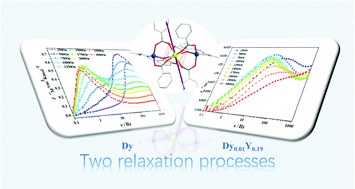当前位置:
X-MOL 学术
›
Dalton Trans.
›
论文详情
Our official English website, www.x-mol.net, welcomes your
feedback! (Note: you will need to create a separate account there.)
Two {Zn II2DyIII} complexes supported by monophenoxido/dicarboxylate bridges with multiple relaxation processes: carboxylato ancillary ligand-controlled magnetic anisotropy in square antiprismatic DyIII species†
Dalton Transactions ( IF 3.5 ) Pub Date : 2018-06-19 00:00:00 , DOI: 10.1039/c8dt01842a Min Li 1, 2, 3, 4, 5 , Haipeng Wu 1, 2, 3, 4, 5 , Qing Wei 1, 2, 3, 4, 5 , Hongshan Ke 1, 2, 3, 4, 5 , Bing Yin 1, 2, 3, 4, 5 , Sheng Zhang 1, 2, 3, 4, 5 , Xingqiang Lv 3, 5, 6, 7 , Gang Xie 1, 2, 3, 4, 5 , Sanping Chen 1, 2, 3, 4, 5
Dalton Transactions ( IF 3.5 ) Pub Date : 2018-06-19 00:00:00 , DOI: 10.1039/c8dt01842a Min Li 1, 2, 3, 4, 5 , Haipeng Wu 1, 2, 3, 4, 5 , Qing Wei 1, 2, 3, 4, 5 , Hongshan Ke 1, 2, 3, 4, 5 , Bing Yin 1, 2, 3, 4, 5 , Sheng Zhang 1, 2, 3, 4, 5 , Xingqiang Lv 3, 5, 6, 7 , Gang Xie 1, 2, 3, 4, 5 , Sanping Chen 1, 2, 3, 4, 5
Affiliation

|
Two linear-shaped heterometallic trinuclear {ZnII2DyIII} clusters were prepared with a compartmental Schiff-base ligand and carboxylate as the co-ligand. The central DyIII ion is sandwiched by two [ZnHhms(RCOO)2] (H2hms = (2-hydroxy-3-methoxybenzylidene)-semicarbazide) units to form a distorted square antiprismatic (SAP) geometry with D4d symmetry. The DyIII and ZnII ions are triply bridged by one unique monophenoxido/dicarboxylate group, where one of the carboxylates shows a severe angular distortion. The magnetic analysis revealed a field-dependent change with two relaxation processes in 1 and 2, which originated from the molecular magnetic center and dipolar–dipolar coupling. The dipole-induced slow relaxation disappeared upon magnetic-site dilution, while another faster relaxation appeared in the high frequency region associated with the different distortions of the antiprismatic sites for 1 and disordered structures for 2. Ab initio calculations revealed that two {ZnII2DyIII}-carboxylate complexes are axial in nature, but the remarkable quantum tunnelling of the magnetization exists in the ground state, which lowers the anisotropic barrier and prohibits zero-field single-molecule magnet behavior. The crystal field of the carboxylato ancillary ligands produces a competitive effect with the phenoxido bridging ligands on the magnetic anisotropy of the lanthanide ions, which greatly affects the electrostatic distribution of this type of {ZnII2DyIII} single-ion magnets (SIMs). The results offer a model for further investigating structural factors in the relaxation mechanism of SIM systems.
中文翻译:

由单苯甲酰氧基/二羧酸酯桥支持的 两个{Zn II 2 Dy III }配合物,具有多个弛豫过程:方形反棱晶Dy III物种中的羧基辅助配体控制的磁各向异性†
制备了两个线性的异金属三核{Zn II 2 Dy III }团簇,其具有间隔的席夫碱配体和羧酸盐作为共配体。中心Dy III离子夹在两个[ZnHhms(RCOO)2 ](H 2 hms =(2-羟基-3-甲氧基亚苄基)-氨基脲)单元之间,形成具有D 4d对称性的扭曲方形反棱柱形(SAP)几何形状。Dy III和Zn II离子由一个独特的单苯氧基/二羧酸酯基三重桥接,其中一个羧酸酯具有严重的角度畸变。磁分析揭示了一个与磁场有关的变化,其中两个弛豫过程为1和2,起源于分子磁中心和偶极-偶极耦合。偶极子引起的缓慢弛豫在磁性位点稀释后消失,而另一快速弛豫出现在高频区域,与1的反棱形位点和2的无序结构的不同变形有关。从头算计算得出两个{Zn II 2 Dy IIIcarboxy-羧酸盐配合物本质上是轴向的,但是在基态中存在显着的磁化量子隧穿,这降低了各向异性势垒并禁止了零场单分子磁体的行为。羧酸根辅助配体的晶体场与苯氧基桥联配体在镧系元素离子的磁各向异性上产生竞争效应,这极大地影响了这类{Zn II 2 Dy III }单离子磁体(SIMs)的静电分布。结果为进一步研究SIM系统松弛机制中的结构因素提供了模型。
更新日期:2018-06-19
中文翻译:

由单苯甲酰氧基/二羧酸酯桥支持的 两个{Zn II 2 Dy III }配合物,具有多个弛豫过程:方形反棱晶Dy III物种中的羧基辅助配体控制的磁各向异性†
制备了两个线性的异金属三核{Zn II 2 Dy III }团簇,其具有间隔的席夫碱配体和羧酸盐作为共配体。中心Dy III离子夹在两个[ZnHhms(RCOO)2 ](H 2 hms =(2-羟基-3-甲氧基亚苄基)-氨基脲)单元之间,形成具有D 4d对称性的扭曲方形反棱柱形(SAP)几何形状。Dy III和Zn II离子由一个独特的单苯氧基/二羧酸酯基三重桥接,其中一个羧酸酯具有严重的角度畸变。磁分析揭示了一个与磁场有关的变化,其中两个弛豫过程为1和2,起源于分子磁中心和偶极-偶极耦合。偶极子引起的缓慢弛豫在磁性位点稀释后消失,而另一快速弛豫出现在高频区域,与1的反棱形位点和2的无序结构的不同变形有关。从头算计算得出两个{Zn II 2 Dy IIIcarboxy-羧酸盐配合物本质上是轴向的,但是在基态中存在显着的磁化量子隧穿,这降低了各向异性势垒并禁止了零场单分子磁体的行为。羧酸根辅助配体的晶体场与苯氧基桥联配体在镧系元素离子的磁各向异性上产生竞争效应,这极大地影响了这类{Zn II 2 Dy III }单离子磁体(SIMs)的静电分布。结果为进一步研究SIM系统松弛机制中的结构因素提供了模型。











































 京公网安备 11010802027423号
京公网安备 11010802027423号